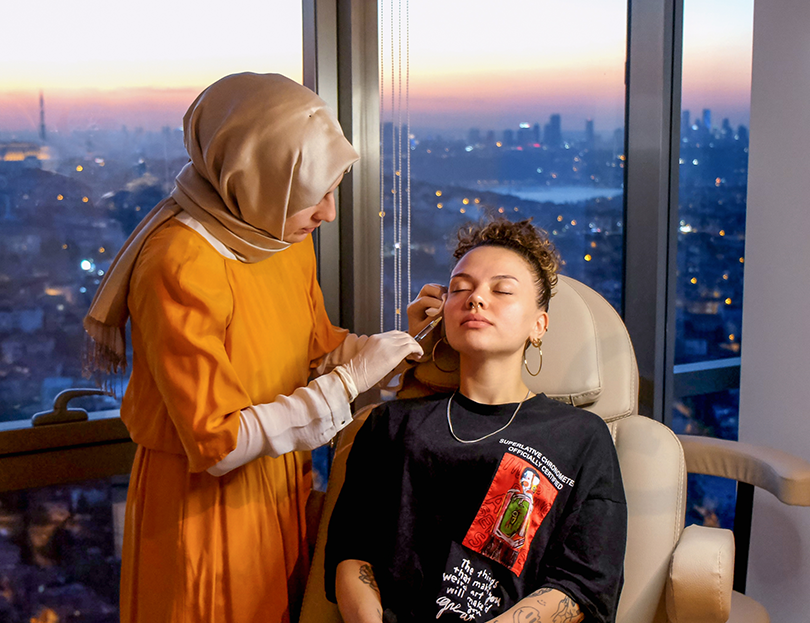Derived from the bacterium Clostridium botulinum, botulinum toxin is an FDA-approved toxin commonly used in dermatology for treating wrinkles, facial contouring, and excessive sweating.
Botulinum toxin (BT) has been used for cosmetic purposes in treating facial wrinkles for the past 30 years. Understanding the properties of the toxin and application methods is the most crucial factor influencing the results.
Wrinkles primarily develop due to skin aging, ultraviolet exposure, and excessive facial expressions. Lines that appear during movement and aren’t visible at rest are called “dynamic wrinkles,” while lines that are visible even at rest are referred to as “static wrinkles.” Dynamic wrinkles often result from excessive facial muscle movements. BT treatment eliminates excessive muscle function, effectively addressing dynamic wrinkles, and providing a safe and satisfying outcome for patients.
Expert physicians perform botulinum toxin applications, which help both alleviate existing wrinkles without distorting the natural expression and prevent the formation of wrinkles when done in appropriate doses (Preventive Botox).
Types of Botulinum Toxin Applications
The most commonly treated areas include the forehead, glabella (between the eyebrows), and crow’s feet. In addition, there are various application areas based on individual needs, such as the corners of the mouth, upper lip, jawline, and jaw muscle.
- Glabellar Botox
This application is performed to eliminate the lines between the eyebrows caused by frowning.
- Upper Lip Botox
Commonly used to address vertical lines on the upper lip, which are more pronounced in individuals who smoke or undergo waxing in the mustache area.
- Crow’s Feet Botox
Applied to reduce the radial wrinkles around the eyes, this treatment also lifts the brow. It makes individuals appear younger and more vibrant.
- Treatment of Forehead Lines
This is an effective and safe treatment for horizontal lines on the forehead resulting from the constant use of forehead muscles.
However, it’s essential not to apply the toxin to certain points on the forehead or in high doses. This is because it can lead to eyebrow drooping. But when performed by experienced professionals, this risk is eliminated.
- Masseter Botox
This treatment aims to thin the chewing muscles in the lower part of the face. It is applied to individuals who suffer from excessive teeth grinding.
It also shapes the face. It has been described as creating a square face line in men and a thinner and softer line, known as the “ideal jaw structure,” in women.
For individuals with square and round face structures, multiple sessions of this treatment can result in a non-surgical transformation to more delicate lines.
- Excessive Sweating Botox
Various treatment alternatives are available for excessive sweating. These treatments are either insufficient or can lead to systemic side effects with anticholinergic drugs.
As a result, toxin application is a promising treatment option for sweating issues.
Significant improvements in quality of life have been observed in individuals treated with toxin for hyperhidrosis.
It is used for hand and foot sweating, as well as underarm sweating.
- Preventive Botox
This has become a popular choice in recent times. The goal is to prevent the settlement of dynamic wrinkles that begin to form in their 20s. When administered in appropriate doses, it doesn’t distort the natural expression or result in a frozen appearance.
- BROTOX (Botox treatment for men)
The anatomy and muscle strength in men differ from women. Therefore, planning must be done to preserve a masculine expression.
Particularly, the forehead muscles are quite strong, and men often request toxin treatment for this area.
- Natural / Minimal / Baby Botox / Actor’s Botox
Patients who want botulinum toxin treatment often fear having an overly frozen expression or losing their natural look.
In this application, injections are planned in minimal doses and appropriate areas, considering the person’s age and natural facial expressions.
Botulinum Toxin Application Process
Botulinum toxin is applied through injection in sterile conditions.
During the procedure, there is no pain felt, but there might be a slight burning sensation.
The procedure takes 15-20 minutes, and patients can continue their daily activities afterward.
For 24 hours after the procedure, individuals should avoid touching the treated areas, massaging them, bending forward, letting water touch them, lying face down, and consuming alcoholic beverages.
The effects start to appear 24-72 hours after the application and fully develop within 7-14 days. The effects of the toxin are not permanent; muscle function usually returns after 4-6 months. With repeated injections, this duration may extend.
Administering high doses in a single session or frequent injections can lead to the development of antibodies against the toxin, rendering it ineffective.


